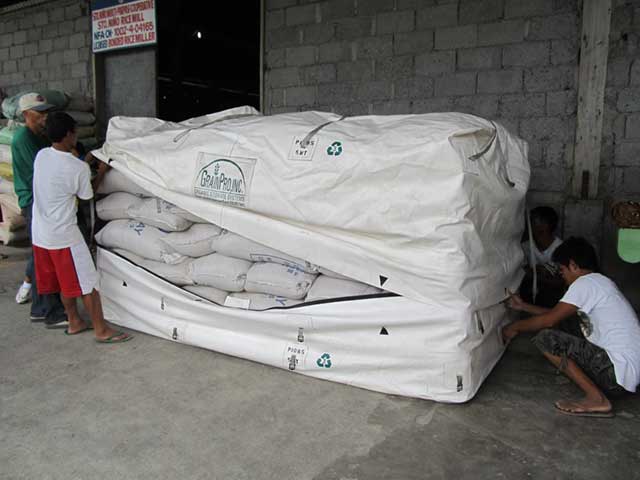Cocoon
 The Cocoon™ is a commercially available hermetic storage container that consists of two plastic halfs that are joined together with an air-tight zipper after the cocoon is loaded with sacks of the commodity to be stored.
The Cocoon™ is a commercially available hermetic storage container that consists of two plastic halfs that are joined together with an air-tight zipper after the cocoon is loaded with sacks of the commodity to be stored.
(Cocoons are made by GrainPro. While IRRI is not endorsing a specific manufacturer, GrainPro is currently the only manufacturer of hermetic Cocoons we are aware of.)
Why is a Cocoon important and how does it work?
Compared to traditional storage systems, Cocoons have the following benefits:
- Extend the germination life of seeds,
- Control insect grain pests without chemicals), and
- Improve the head rice recovery of stored grain.
Cocoons reduce the flow of both oxygen and water between the stored grain or seed and the outside atmosphere. When properly sealed, respiration of grain and insects inside the bag reduce oxygen levels from 21% to 5%. This reduction reduces live insects to less than 1 insect/kg of grain without using insecticides - often within 10 days of sealing. The stablized moisture inside the cocoon prevents wetting and drying of grain. This reduces the extent of grain cracking and so head rice recoveries are higher upon milling.
How to store your grain in a cocoon
For details on how to load the Cocoon refer to the manufacturers manual. They come in different sizes and configurations e.g. for bulk or bag storage. Some general guidelines include:
- Clean the seed or grain and dry to the correct moisture content. (seed 12%, grain 14%). Use a moisture meter.
- Make sure the Cocoon is clean and undamaged.
- Seal the Cocoon according to the manufactures recommendation.
- Store the containers either undercover or in the shade.
- Use an oxygen meter to measure oxygen content inside the cocoon, first daily and once the oxygen has dropped weekly to monitor that the Cocoon is properly sealed.
Management Issues
While the technology is simple users sometimes still have bad experiences when the oxygen levels are higher than expected. This is often due to poor management. The following points are important.
- Intermittent opening and closing allows oxygen re-entry which can lead to the rapid re-infestation of some insects such as lesser grain borer which can pierce plastic liners.
- Cocoons can be damaged by rodents if not managed correctly. Pull plastic liners tight and keep a clear space around the containers.
- Mechanical damage or placing cigarette buts on the Cocoon can also damage it.










